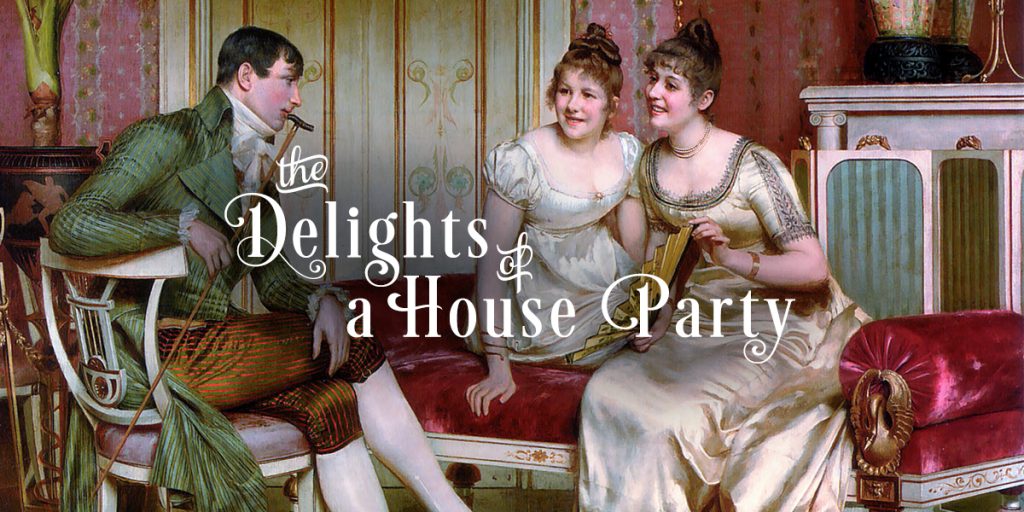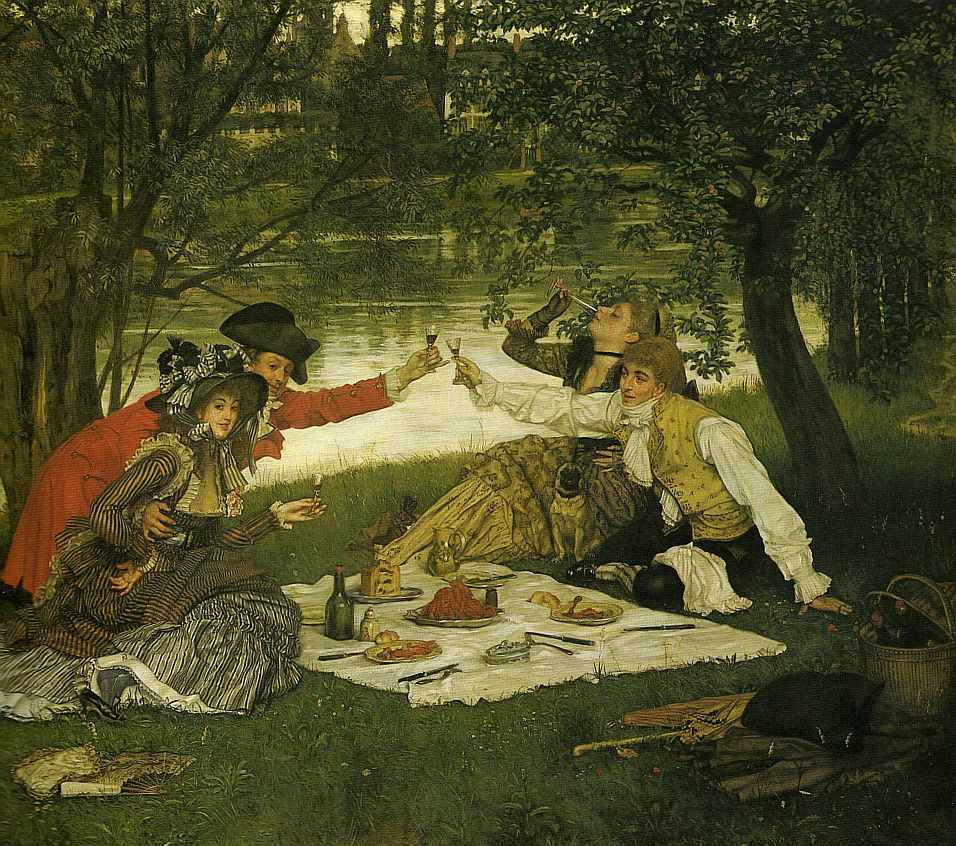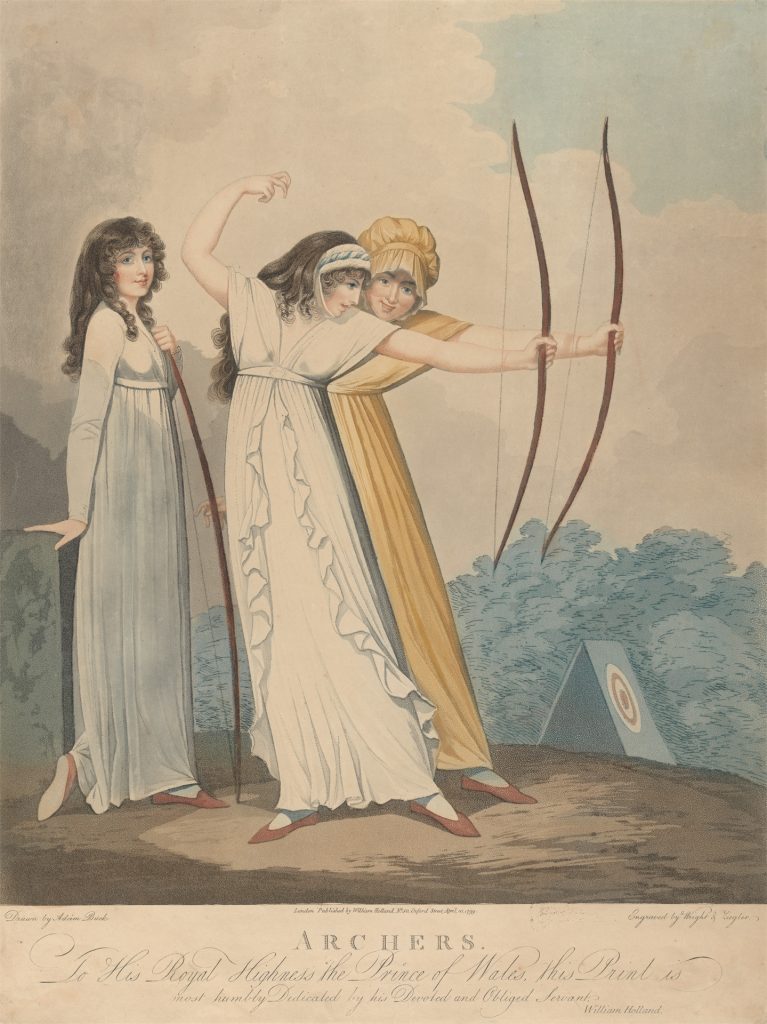The Pinnacle of Country Entertaining

Summer vacation season is rapidly descending upon us. As we are trying to plan a bit of a vacation later in the summer, I naturally began thinking about the sort of summer vacations that might have been planned during the Regency era—because of course that is what everyone things about while contemplating summer travel, right? Yes, that is my husband shaking his head in the background.
Although trips to visit various natural and man-made wonders were certainly undertaken, one Regency era option struck me as very unlike modern options, the centuries old tradition of the country house party.
On the whole, during the Regency era, the upper echelons of society generally preferred to congregate in London whenever possible. After all, it was the center of all things cultured and good. But the heat of August made London extremely unpleasant—hot, sticky, smelly. So, with Parliament out of session and the all-important ‘Season’ winding to a close, (not to mention the hunting and shooting seasons starting soon) those who could afford to do so headed for the cooler climes of the countryside.

The fortunate few with country seats often invited friends and family to gather with them on their estates—an opportunity to lengthen the social season a bit, with limited and particularly chosen company in the comfort and slower pace of the countryside. These informal gatherings of friends could simply be convivial in nature, but it wasn’t uncommon for social, marital or political advancement to be underlying motives as well. (How better to gain the ear of an influential parliamentarian than to have him at your dining table and drawing room night after night? And who could possibly object to giving eligible young people the opportunity to get to know each other away from the London crush? So, yeah, they could also be the focal point for a lot of interpersonal drama, but I digress…)
House parties lasted anywhere from three to four days up to a month. With the difficulties and expense of traveling over dangerous and badly maintained roads, long stays made sense—at least for the guests. What the hostess thought of them could be an entirely different matter—and the subject of an upcoming post.
An Expensive Affair
While running a country estate was often an expensive prospect, hosting a house party brought that expense to a whole different level. Since the entire affair often amounted to calculated display of wealth, guests were often treated to the best of everything. Said guests also probably expected what they experienced to be the best the host and hostess could offer and likely made judgement accordingly. No doubt much talk would be generated by what was or was not provided to a house party’s guests.
Servants might be outfitted with new livery and additional servants hired for the duration to accommodate the needs of the guests. The best glasses, china, and silver were used for meals—which meant a lot of extra labor for the servants (or sometimes they were purchased for the occasion!)
Then there was the food! Gracious, just so much food. It wasn’t just a matter of the extra mouths of the guests and their servants to feed. That would have been far more manageable.

Hosts were expected to serve lavish dinners which could include dozens of dishes for each dinner, not to mention expensive (and often imported) alcohol and desserts. It was not unknown for families to live very modestly apart from the house parties in order to afford their guests when they came. The alternative might be incurring heavy debts for the endeavor.
Entertaining the guests also came with a cost. Indoor entertainments might seem inexpensive, but writing papers for letters, new sheet music for the pianoforte, fresh decks if cards, new games, and even the accoutrement for home theatricals could add up quickly. And if balls and parties were held as well, musicians, food, and candles to light the long evenings had to be acquired.
If outdoor amusements were pursued, then fishing tackle and shooting supplies might have to be provided. Horses and their tack would have to be managed for those who chose to ride or drive. Equipment for outside games like lawn tennis, croquet or lawn bowls might need to be obtained or at minimum maintained.
All this is not to say that guests’ pocketbooks escaped unscathed. Since house parties were often an opportunity for ostentatious displays of wealth, guests brought their finest fashions, many, many of them. Informal garments for morning, outfits for sport, attire for receiving visitors, apparel for balls, formal dress for dinner. Clothes. All of the clothes. So many, that new clothes might have to be acquired or older ones freshened up in anticipation of the visit. Even if a house guest did not incur expenses for new clothes, they still have to face the issue of vails.

Vails were tips for the servants who attended one while visiting. Every servant one interacted with from the porter who carried bags in from the carriage to the maid who made up the room each day, expected recompense from you for the extra work a guest caused them. The expense was heavy enough that some would forgo a house party to avoid the cost! While an invitation to a house party might be exciting to receive, it behooved one to count the cost before accepting.
Entertainment at a house party
If one braved the dangers of travel and the burden of the expenses, what did one actually do at a house party?
The reality was probably a bit different from what a modern guest might expect. During the day, guests were largely responsible for their own entertainment, availing themselves of the amenities of the estate. Typically, the day’s activities kept the gender’s segregated until dinner, although if a couple was determined to spent some time together, it could certainly happen.

Breakfast would be set out to be enjoyed individually, according to one’s preferred time to rise. The men were often up early, enjoying a substantial breakfast before heading out for fishing, shooting or hunting. Riding and boating might also be on the agenda. If the weather were disagreeable, billiards—which ladies generally did not play—might also be an option.
Ladies often rose much later, and sometimes kept to their rooms to write letters or read before breakfast. A majority of the activities open to the ladies centered around the house. They might read, write letters, practice their music, share patterns with the other ladies and sew. (Unless they were actively doing something else, women almost always had needlework in their hands, but that’s another post…) Often neighbors would call on the visitors. as polite society demanded. Those social calls would be repaid a day or two later. Visits to local places of interest might also be arranged.
If the ladies desired outdoor amusements, they might go for walks or carriage rides, or watch the men plays sports. Certain outdoor games were considered appropriate for ladies including croquet, lawn tennis, archery, shuttlecock, and lawn bowls. It should be noted, appropriate garments would be required for these activities.

Lunch was a relatively new innovation during the Regency. Oftentimes a midday repast was an informal meal set out on the sideboards in whatever room people gathered. The dining room would not be used for such a meal. The foods served and the time a midday meal would be served would depend on the dinner hour of the house.
Dinner was the main mean of the day and the major event of most days. It could be served as early a 2 pm, although that would be considered rather low class, or as late as 6 or even 7 pm. The later the hour, the more fashionable it was considered to be. Dinner was a formal occasion and required formal dress. Men and women were expected to dress accordingly and present themselves in the drawing room about a quarter of an hour before the dinner hour. Now at last, after a day of leisure, ladies and gentlemen joined each other’s company.
Dinner was a lavish affair with typically two courses and possibly a dessert course served. Each course could consist of as many two dozen different dishes. The meal could easily last two hours or more. After dinner, typically the hostess would escort the ladies to the drawing room to allow the men some time to themselves. (As though they did not have enough of that during the day—but I digress.) During this time, men would enjoy port, cigars, and manly conversation not appropriate in front of the ladies.

While the ladies waited for the men to join them in the drawing room, they might converse, play games, perform music, and for some, be glad not to be in the company of drinking men and coarse conversation. The men might trickle in as they saw fit or might join the ladies en masse for the evening’s entertainments.
Unless they were going out to attend a public assembly (ball) or other public entertainment, the group would remain in the drawing room until they retired. Tea and light refreshments would be brought to the drawing room for the company to enjoy as they focused on the pleasing art of conversation. Games, like charades and other parlor games, board games and cards often helped pass the time. Because high-stakes gambling wreaked havoc among the upper classes, it was not unusual for hostesses to limit the amount that could be bet on games in the house. Musical performances, home theatricals and informal dances could also be employed for evening entertainments.
House parties continued to be enjoyed well into the Edwardian era. However, as transportation improved, the events grew shorter, often just a few days in length. I can’t help but image hostesses would have appreciated that change immensely.

6 comments
1 pings
Skip to comment form
I’ve always been fascinated by these parties.
Author
Me too! A month is a really long time for a visit, isn’t it?
Thank you for this post! I will be entertaining my sister as a houseguest for several days next week, but not on nearly so grand a scale! And I have no servants for her to tip, although I’m sure the cats would appreciate a catnip mouse or two in return for having their routine disrupted. It never occurred to me before that guests might be expected to tip the servants!
Author
The last time I was a house guest, honest to goodness, I brought a package of cat-nip mice for the resident felines!
This was an interesting post. All that company for that long would be wearing upon me. I like small groups. Thank you for this informative post.
Wonderful post!! A country house party sounds like a nightmare!
[…] aspects that defined country house parties in the Regency era. This delightful and informative blog by Maria Grace is full of fascinating facts on this […]